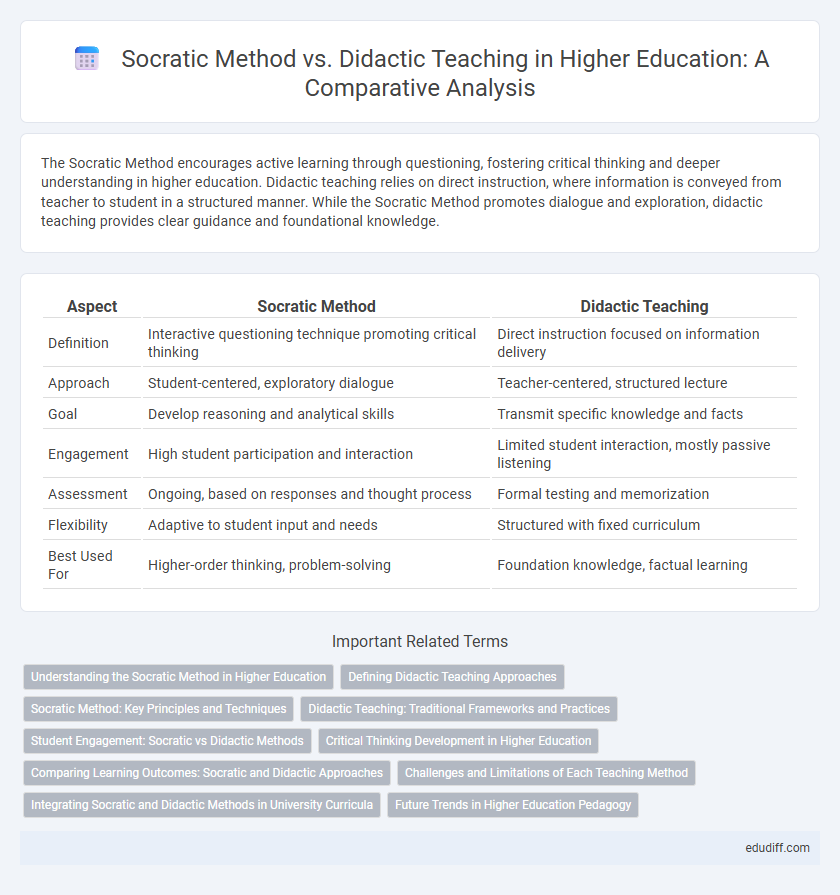The Socratic Method encourages active learning through questioning, fostering critical thinking and deeper understanding in higher education. Didactic teaching relies on direct instruction, where information is conveyed from teacher to student in a structured manner. While the Socratic Method promotes dialogue and exploration, didactic teaching provides clear guidance and foundational knowledge.
Table of Comparison
| Aspect | Socratic Method | Didactic Teaching |
|---|---|---|
| Definition | Interactive questioning technique promoting critical thinking | Direct instruction focused on information delivery |
| Approach | Student-centered, exploratory dialogue | Teacher-centered, structured lecture |
| Goal | Develop reasoning and analytical skills | Transmit specific knowledge and facts |
| Engagement | High student participation and interaction | Limited student interaction, mostly passive listening |
| Assessment | Ongoing, based on responses and thought process | Formal testing and memorization |
| Flexibility | Adaptive to student input and needs | Structured with fixed curriculum |
| Best Used For | Higher-order thinking, problem-solving | Foundation knowledge, factual learning |
Understanding the Socratic Method in Higher Education
The Socratic Method in higher education emphasizes critical thinking and active dialogue, fostering deeper understanding through questioning rather than direct instruction. This approach encourages students to engage with complex concepts, challenge assumptions, and develop independent reasoning skills. By contrast, didactic teaching often relies on information delivery, which can limit critical engagement and the development of analytical abilities.
Defining Didactic Teaching Approaches
Didactic teaching approaches emphasize structured, teacher-centered instruction where information is presented clearly and systematically to facilitate knowledge acquisition. This method relies heavily on lectures, demonstrations, and rote memorization, aiming for efficient content delivery and mastery of specific subject matter. It contrasts with the Socratic method by prioritizing direct transmission of facts over guided questioning and critical dialogue.
Socratic Method: Key Principles and Techniques
The Socratic Method emphasizes critical thinking through guided questioning, enabling learners to explore complex ideas deeply and independently. Key techniques include dialectical questioning, which challenges assumptions and encourages reflective dialogue, and the use of analogies to clarify abstract concepts. This method fosters active engagement and cognitive development, contrasting with the passive reception typical of didactic teaching.
Didactic Teaching: Traditional Frameworks and Practices
Didactic teaching emphasizes structured lessons where instructors deliver content directly to students, ensuring consistent knowledge transmission through predetermined curricula. This traditional framework prioritizes clear objectives, standardized assessment methods, and teacher-led explanations to facilitate efficient learning in various educational settings. Evidence shows that didactic practices enhance foundational knowledge acquisition, especially in disciplines requiring precise information retention.
Student Engagement: Socratic vs Didactic Methods
The Socratic Method significantly enhances student engagement by promoting critical thinking through dialogue and questioning, encouraging active participation and deeper understanding. Didactic teaching, while efficient for content delivery, often results in passive learning, limiting students' opportunities to interact and reflect. Research indicates that Socratic techniques foster higher retention and motivation by involving learners directly in the learning process.
Critical Thinking Development in Higher Education
The Socratic Method enhances critical thinking development in higher education by encouraging active questioning and dialogue, promoting deeper analysis and self-reflection. In contrast, didactic teaching often delivers information unilaterally, which may limit student engagement and critical inquiry. Research indicates that students exposed to Socratic techniques demonstrate improved problem-solving skills and higher-order cognitive abilities essential for academic and professional success.
Comparing Learning Outcomes: Socratic and Didactic Approaches
The Socratic Method enhances critical thinking and deep comprehension by engaging students in dialogue, encouraging questions, and fostering active participation, which leads to improved problem-solving skills and retention. Didactic teaching, characterized by structured lectures and direct instruction, efficiently delivers foundational knowledge but often results in passive learning and limited analytical development. Empirical studies indicate that students exposed to Socratic questioning outperform their peers in critical reasoning assessments, while didactic approaches excel in standardized test performance for factual recall.
Challenges and Limitations of Each Teaching Method
The Socratic Method poses challenges such as time consumption and the potential for student discomfort due to its interrogative nature, which can hinder participation in diverse classrooms. Didactic teaching often faces limitations including reduced student engagement and limited critical thinking development, as it relies heavily on passive knowledge transmission. Both methods require careful adaptation to balance instructional effectiveness with student needs and learning styles.
Integrating Socratic and Didactic Methods in University Curricula
Integrating Socratic and didactic methods in university curricula enhances critical thinking by combining structured knowledge delivery with guided inquiry. This hybrid approach allows students to engage deeply with content through dialogue while retaining clear, foundational concepts presented by instructors. Universities adopting this integration report improved student engagement, comprehension, and analytical skills across diverse disciplines.
Future Trends in Higher Education Pedagogy
Emerging trends in higher education pedagogy emphasize the integration of the Socratic Method to foster critical thinking and active learning, contrasting with the traditional didactic teaching approach centered on information delivery. Advances in digital technology and AI-powered adaptive learning platforms enhance the efficacy of dialog-based instruction, making the Socratic Method more scalable and personalized. Future-oriented institutions prioritize hybrid models that combine guided inquiry with targeted content mastery to optimize student engagement and deeper understanding.
Socratic Method vs Didactic Teaching Infographic

 edudiff.com
edudiff.com